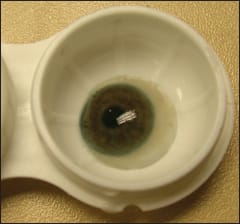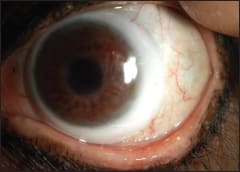CL Design & Materials
Soft Prosthetic Lens Options


BY RONALD K. WATANABE, OD, FAAO, & CRYSTAL REMINGTON, OD
Using prosthetic contact lenses to improve cosmesis for patients who have anterior segment deformities can be a challenging but rewarding experience. Patients who have photophobia also may find relief with prosthetic lenses that have a black annulus backing and color-matched iris.
Standard Prosthetic Lenses
Some companies offer prosthetic contact lenses in a standard variety of colors and specifications. Orion Vision Group (formerly Marietta Vision) uses methafilcon A in three color styles, with or without an outlining limbal ring.
Alden Optical offers a range of brown colors in powers of plano to ±30.00D and cylinders up to −10.00D, made to order in either hioxifilcon B or polymacon.
Nissel Naturals (UK-based Cantor + Nissel, formerly Cooper Prosthetics, manufactured by Advanced Vision Technologies and Medcorp International) feature a standard set of brown, blue, and green options on an opaque background in hioxifilcon A. Cantor Prosthetics lenses feature computer-generated color reproducibility technology with either a black or clear background.
Custom Color Contacts offers both prosthetic and cosmetic options using a color-bonded process with a 49-percent material.
Overall, standard computer-generated coloring is more cost-effective and reproducible compared to hand-painted lenses and is a great first option to consider.
Custom Hand-Painted Lenses
Eye color is influenced by center surround phenomena, which can be altered by individual coloring, the conjunctiva, and the cornea itself (Mackey et al, 2011). The dynamic nature of eye color increases the difficulty of achieving a perfect match in a contact lens, particularly in light-colored irides. Sometimes these factors do not allow a standard prosthetic lens to achieve a visually appealing match. Such cases may require hand-painted lenses. Adventure in Colors, Crystal Reflections International, and Specialty Tint require practitioners to provide the contact lens, while they provide tinting and coloring services. Custom Color Contacts, Medcorp International, and Orion Vision Group also provide hand-painted lenses.

Figure 1. Hand-painted prosthetic contact lens with decentered iris (Adventure in Colors).

Figure 2. Decentered iris prosthetic lens on the eye.
When ordering custom hand-painted lenses, it is imperative to provide a true color photo of the matching eye. Take the photograph in illumination that is as natural as possible, and have the patient wear white clothing or place white paper under the chin. One or two sample lenses may be created for the patient to try. Take additional photos that include both eyes to document any changes needed in the sample lens to improve the match.
When fitting patients who have an ocular misalignment, prism-ballasted, large-diameter lenses (up to 24 mm) allow the iris print to be located off-center (Figures 1 and 2).
Managing patient expectations allows any contact lens fitter to help patients who have even the most disfigured eyes. CLS
To obtain references for this article, please visit http://www.clspectrum.com/references.asp and click on document #210.
Dr. Watanabe is an associate professor of optometry at the New England College of Optometry. You can reach him at watanaber@neco.edu. Dr. Remington graduated from the New England College of Optometry and is currently a resident in Cornea and Contact Lenses there.



